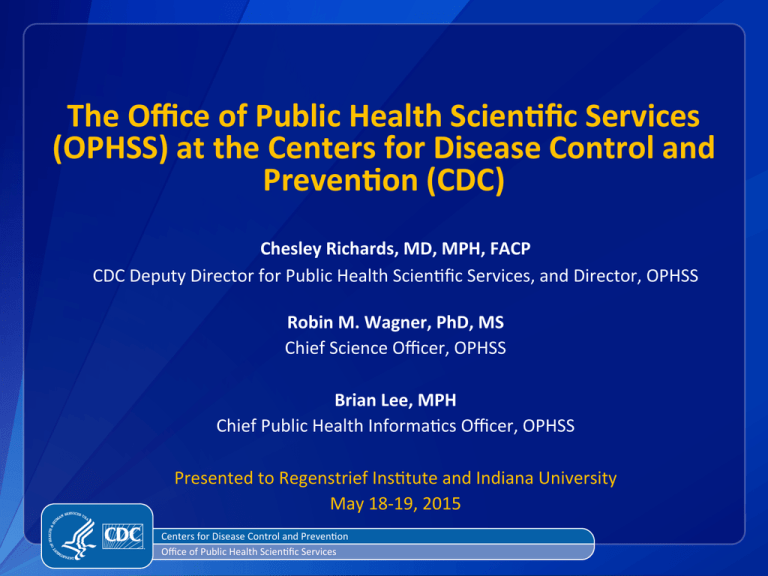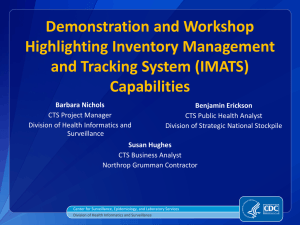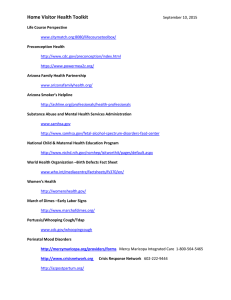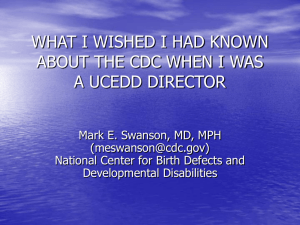Document 10772633
advertisement

The Office of Public Health Scien4fic Services (OPHSS) at the Centers for Disease Control and Preven4on (CDC) Chesley Richards, MD, MPH, FACP CDC Deputy Director for Public Health Scien6fic Services, and Director, OPHSS Robin M. Wagner, PhD, MS Chief Science Officer, OPHSS Brian Lee, MPH Chief Public Health Informa6cs Officer, OPHSS Presented to Regenstrief Ins6tute and Indiana University May 18-­‐19, 2015 Centers for Disease Control and Preven6on Office of Public Health Scien6fic Services CDC Strategic Directions Improve health security at home and around the world Better prevent the leading causes of illness, injury, disability, and death Health Care Public Health Strengthen public health/ health care collaboration CDC Resources in OPHSS OPHSS has cross cuIng responsibility for the tools of public health… Epidemiology and Surveillance Health Sta6s6cs Informa6cs Laboratory Quality Scien6fic Guidelines Scien6fic Workforce Scien6fic Communica6on Knowledge for public health action Surveillance Challenges Prolifera4on • >120 surveillance systems or ac4vi4es at CDC Silos • Interconnec4ons, interdependencies, efficiencies unrealized • Local/state health departments: many systems/requirements Innova4on and Resources • Slow adop4on of new technologies • Insufficient workforce with the right skills in the right places Emerging Health Informa4on Policies • Electronic Health Records and Meaningful Use Standards • Interoperability Requirements Calls for Enhancements to CDC Surveillance Systems • Congressional FY 2015 budget language requires CDC to “develop a 4meline for a cloud-­‐based and flexible IT public health data repor4ng pla^orm for CDC programs” • Council of State and Territorial Epidemiologists has asked CDC to evaluate which data elements are truly needed for surveillance and to coordinate across CDC programs to harmonize and standardize data elements • CDC Director charged Office of Public Health Scien4fic Services to lead the CDC surveillance strategy CDC Surveillance Strategy Improve availability and 4meliness of surveillance data Advance effec4ve use of emerging informa4on technology Iden4fy and amend or re4re ineffec4ve or redundant surveillance systems Maximize effec4veness of resources, and performance and coordina4on of surveillance systems Surveillance Strategy Ac4vi4es and Ini4a4ves Ac4vi4es • Surveillance Leadership Board • CDC Health Informa4cs Innova4on Consor4um • HIT Policy Commiaee (FACA) representa4on • Strategic Health IT Vendor Forum Ini4a4ves • Mortality sta4s4cs—Electronic Death Repor4ng • Lab repor4ng—Electronic Lab Repor4ng • Syndromic Surveillance—Visualiza4on and Analy4cs • No4fiable Diseases—Electronic Repor4ng Addi4onal Informa4on on CDC Surveillance Strategy • CDC Internet Site: http://www.cdc.gov/surveillance/ • “Surveillance Strategy: A strategy for improving CDC’s ac4vi4es in public health surveillance”: hap://www.cdc.gov/ophss/docs/cdc-­‐surveillance-­‐ strategy-­‐final.pdf Concluding Thoughts Data are essen4al to improve popula4on health • Triangulate health problems to produce accurate picture • Help understand needed solu4ons • Advance knowledge of effec4ve interven4ons • Provide ongoing feedback on success Many opportuni4es • Data analy4cs exist to • Evidence for community and popula4on promote interven4ons health and • Collabora4ons preven4on Thank You! Ques4ons? For more informa4on please contact Centers for Disease Control and Preven4on 1600 CliSon Road NE, Atlanta, GA 30333 Telephone: 1-­‐800-­‐CDC-­‐INFO (232-­‐4636)/TTY: 1-­‐888-­‐232-­‐6348 Visit: www.cdc.gov | Contact CDC at: 1-­‐800-­‐CDC-­‐INFO or www.cdc.gov/info The findings and conclusions in this report are those of the authors and do not necessarily represent the official posi6on of the Centers for Disease Control and Preven6on. Centers for Disease Control and Preven6on Office of Public Health Scien6fic Services







